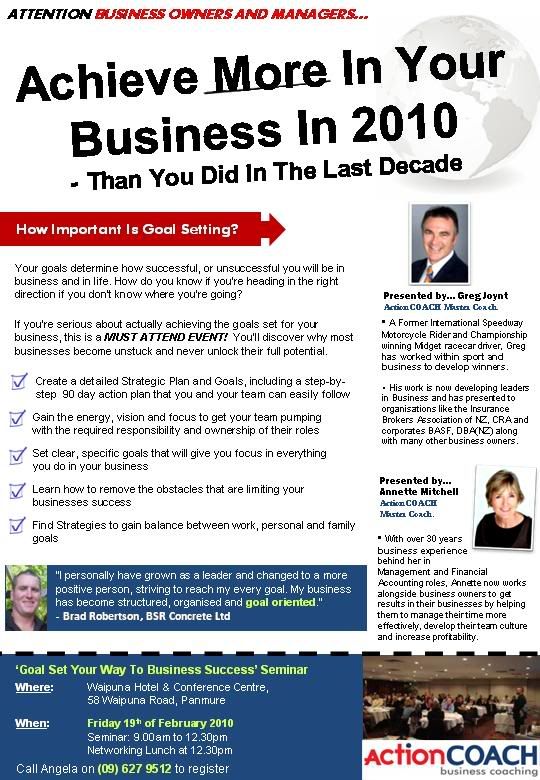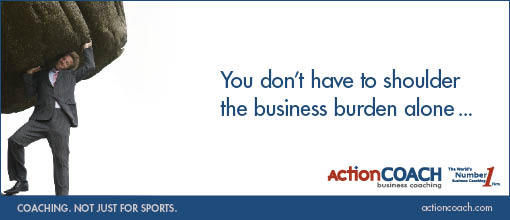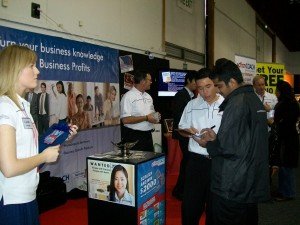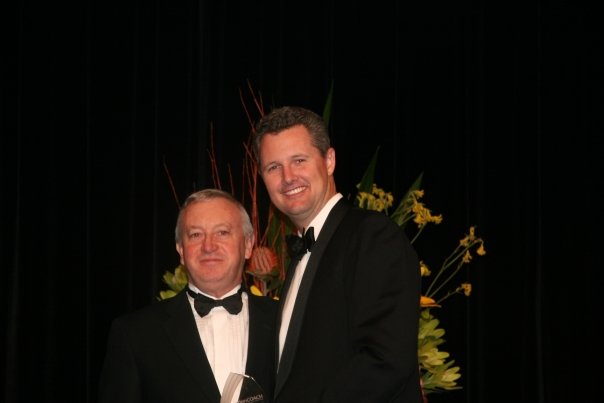
Click Here to Reserve your Seat.
Limited seats available.


1. The Lifestyle of your choice…
In a job, you have to turn up at 9 (usually earlier) and can only leave at 5 (or later). In your own business, you set the schedule. Successful business coaches can arrange their work to suit them. You can work 3 days a week and take holidays when you want. It’s all up to you…
2. The rewards are yours to keep…
In a job, you usually get paid a fixed amount every year no matter how well you do. In a business it’s different, you get paid exactly what you deserve, because you earnt it…
3. The freedom of being an entrepreneur…
In a job, you have to fit your life around your work. Being a business owner is very different. You choose everything. Your Clients, your office and you hours are up to you. You are in control…
____________________________________________________________________________
ActionCOACH Business Coaching New Zealand
The World’s No.1 Business Coaching Firm
Call us FREE Today for a Complimentary Business Coaching Session- 0800 228 466
or Click Here
The bulk of the plan needs to be completed in 5 to 7 minutes. All parts of the plan will be in a single sentence except point 4 which will need to be fleshed out at a later date.
Here are the questions! – (remember answer in one sentence only!)
1) The purpose of your marketing.
2) What is the competitive advantage of your business?
3) Who is your target market/audience?
4) What are the marketing strategies that you’ll use? E.g. Radio, newspaper, customer service training, PR, add on sales training, etc.
5) What’s your niche?
6) What’s your identity – who you really are?
7) Your marketing budget as a percentage of your total budget.
Source: Jay Conrad Levinson – Author of ‘The Guerrilla Marketing Revolution’.
For more Business Tips- please visit our website… www.actioncoachbusinesscoaching.co.nz
We are ActionCOACH Business Coaching New Zealand. We are the biggest and the World’s No. 1 Business Coaching Firm.

Are you participating in an EXPO? Here are some important and vital tips to make the most of your investment…it’s a heafty activity any way so learn this up…
1. Don’t:
Pass up the chance to visit other industry events before you exhibit for the first time. Make note of what exhibitors worked for you and what turned you off. What did you find to be effective? Can you incorporate those items into your own exhibit?
2. Do:
Make a list of goals and objectives for the show. This list should be very specific. Do you want to generate $X in new sales, start a certain number of new business relationships, or spread the word about a new service offering you’re introducing to the market?
3. Don’t:
Get sidetracked by what everyone else is doing – or by what people tell you ‘have’ to do at a tradeshow. You’re at the show to reinforce your expert identity and achieve your goals and objectives. Anything else is off-target.
5. Do:
Be open to creative and new ways of presenting your services. Tradeshow attendees see hundreds of exhibits in the course of one day. You need to be unique and engaging for your display to be memorable.
6. Don’t:
Be afraid to be enthusiastic about your services. If you’re genuinely jazzed up about what you do, attendees will sense that. Enthusiasm is contagious — and more importantly, it sells!
7. Do:
Learn the 80/20 rule and take it to heart. The best exhibitors are those who listen 80% of the time and talk 20%. Focusing on attendees’ wants and needs is a surefire route to success.
8. Don’t:
“Throw Up” on attendees. This very common practice occurs when nervous exhibitors can’t stop talking, and keep up a constant barrage of facts, figures, and sales spiel. Attendees are quickly turned off by this, and your chance to form a profitable new business relationship walks away.
9. Do:
Remember you’re on display. What you’re selling at a tradeshow is, primarily, first impressions. Be professional, well-dressed, and mannerly at all times. You never know who’s watching.
10. Don’t:
Eat, drink, or chat on your cell phone on the show floor. When you need refreshment or a break, leave your exhibit booth. Remember, the eyes of the public are on you at all times, so you’ll want to conduct yourself well.
11. Do:
Be realistic. Tradeshows are long events. You’re on the floor for anywhere from ten to twelve hours at a go, often several days in a row. This is a lot for any one person to do on their own, and most Nichepreneuers are solo operations. Ask for help. Recruit friends to work the show with you. If nothing else, they can spell you while you grab a quick bite to eat.
12. Don’t:
Forget! If you have friends help you at the tradeshow, it behooves you to provide them with some training. Make sure they understand what your services are, how you’re different from your peers, and what the marketing message is. Also, have a plan in place to cover what they should do when they run into a question they don’t know the answer to.
13. Do:
Ask qualifying questions. You want to know who you’re talking to, who they work for, and in what capacity. This will help you determine if the attendee is a prospective customer or not.
14. Don’t:
Be afraid to encourage people to move along if they’re not interested in your services. Some of the people who attend tradeshows are ‘tire-kickers’ — they like to discuss everything, but buy nothing. You don’t want to waste your time with them.
15. Do:
Take notes. Take time before the show to create a lead-card system, in which you’ll record pertinent information to facilitate post-show follow-up.
16. Don’t:
Depend on your memory — no matter how good you are, a few words scrawled on the back of a business card won’t be enough after the show’s over and you’ve met with literally hundreds of people.
17. Do:
Be polite and nice to everyone. The junior executive today can be a senior executive tomorrow.
18. Don’t:
Forget to read the Exhibitor’s Service manual. This is the thick packet of materials you received when you registered for the show. Inside, you’ll find everything you need to know about exhibiting at that particular show — and discover important deadlines for ordering services. Don’t miss those deadlines or you’ll pay more for everything!
19. Do:
Reach out to the media. Have a press kit available in the media room. Be open to interviews — reporters and freelancers often walk the floor looking for stories. If you have something truly newsworthy to announce, schedule a press conference at the show.
20. Don’t:
Forget to advertise your tradeshow participation. Make sure your target audience knows they can see you at the show, where you’ll be, and what they can expect when they visit you.
21. Do:
Follow Up! The most important part of any tradeshow takes place after you leave the building. You see that big pile of leads you’ve gathered? Send them all thank you notes for coming to see you — and follow up with them the most promising prospects quickly. You’ll be glad you did.

ActionCOACH Business Coaching at the Bizzone Expo
22. Don’t:
Hesitate to include hands-on, interactive demonstrations into your exhibit whenever possible. People love to participate. They love to try new things. Most of all, they love to have fun. If you can integrate fun into your exhibit, you’ll have more attendees than you know what to do with.
23. Do:
Use giveaway items that enhance your expert identity. You want items that your attendees will use regularly and reinforce their impression of you as the expert.
24. Don’t:
Get caught up in trendy giveaway items pushed by promotional salespeople. You want to stand out from the crowd, not merge with it.
25. Do:
Give your tradeshow participation a fair chance to work. Results may not be immediate. Rome wasn’t built in a day. But the business relationships you start at tradeshows today can steadily blossom into profitable partnerships tomorrow.
….Do you want more information…tips, systems, strategies….
… at ActionCOACH Business Coaching New Zealand, we will help you develop systems like this…practical and easy to implement to get the results that will directly affect the turn-over of your business.
The first step is to call for a Complimentary Coaching Session.
Each month just 5 business owners are given the opportunity to receive a COMPLIMENTARY 90-minute Coaching Session.
This includes a review of your business, along with:

Contact Us TODAY! 0800-228-466
ActionCOACH Business Coaching New Zealand
PO Box 25-651, St. Heliers, Auckland, New Zealand
or email us- [email protected]
“Every business owner who signs-up for the complimentary coaching session WILL find new ways of increasing profits, getting control of their time and/or creating a business that can operate independently of the owner. I found tremendous clarity from being able to take a step back from my day-to-day problems and reviewing the big picture. – Ty Barns, Key Equity Offices
Sydney, Australia, August 08, 2009 –(PR.com)– Robert McTague was awarded the Coaches’ Choice BrandCOACH at this year’s ActionCOACH Global Conference held in Sydney, Australia.

ActionCOACH’s founder and CEO Brad Sugars welcomed more than 200 coaches from all over the world, including France, UK, Ireland, USA, Canada, Mexico, Portugal, New Zealand, Indonesia and Malaysia.
At the end of the conference, ActionCOACH held a black tie dinner and awards ceremony to honor the “best of best” in the coaching community. Some of these awards were Coaches Choice awards, where the finalists and winners were nominated by fellow Business Coaches.
There were several finalists, but McTague took home the BrandCOACH award.
“McTague has accumulated several awards and honors from ActionCOACH over the years,” Sugars said. “I am proud to award him with the Coaches’ Choice BrandCOACH award.”
McTague’s awards include Rookie of the Year in 2001, Action Man award in 2004, New Zealand Education Foundation Supreme award in 2006, and the Coaches’ Choice BrandCOACH award in 2008. In addition, he is an inducted member of the ActionCOACH President’s Club.
ActionCOACH is the world’s number one business coaching and executive coaching franchise, with more than 1,000 offices in 26 countries. To learn more, go to actioncoachbusinesscoaching.co.nz

“How I made $127,638.04 from one direct-mail campaign using simple proven advertising principles that anyone can learn…”
In an exclusive one-time-only workshop, Marti Amos, NZ’s #1 Ranked Business Coach (Jan 2009) will share with you the secrets behind creating money making advertising that will dirve a herd of customers to your doors within the next 90 days…
In This No Holds Barred Workshop You’ll Discover…
1. The 7 biggest mistakes that most business owners are guilty of in their advertising…and what to do about them!
2. 5 quick and dirty ways to create a powerful headline…that works!
3. 11 ways to create red-hot urgency in your readers mind that will get them to take immediate action to your offer…
4. The 7 critical things you must have in your ad to make it work…
5. How to completely dominate your competitors in the Yellow Pages and have your phone ringing 24/7
6. The big secrets behind testing and measuring that can double or triple your profits from a single ad…
7. How to increase the effectiveness of your website without one additional visitor…
Check Out What Past Attendees Have To Say After Attending The StreetSmart Advertising Workshop…
 “From our 2008 Yellow Pages ad we managed to book 27 jobs which generated $13,139. We tested four different headlines for our 2009 ad and also changed the wording to make it more benefit oriented and customer focused.
“From our 2008 Yellow Pages ad we managed to book 27 jobs which generated $13,139. We tested four different headlines for our 2009 ad and also changed the wording to make it more benefit oriented and customer focused.
In 2009 we have booked 334 jobs which has generated $183,203 in revenue. That’s a massive 1,294% increase in the revenue generated from our ad.”
Regan Frost, Regency Plumbing
“From just 2 ads we have placed in the local Eastern Courier for $650 we have gained 71 enquiries which have generated $22,950. Things are moving – many thanks for all the help and guidance. We realise that there was no way that we would have ‘achieved’ from the start without having engaged your help and input.”
Bernie and Lynne Matthews, Evi-Dent Denture Clinic


Plus, when you register before Friday 21st August (Early Bird) You’ll Also Get These Great Bonus Gifts…For FREE!
Bonus Gift #1 – One FREE ad critique certificate from Marti Amos. Have you got a piece of advertising to send out but you’re unsure whether it’s going to work? Wonder no longer! This certificate entitles you to one FREE ad critique. You simply send in your advertising piece and Marti will sit down for an hour and pick the bones out of your advertisement and then list all the ways in which you can improve its effectiveness (valued at $497)
Bonus Gift #2 – The Headline Generator Kit. Stuck for a headline? This great program takes all the effort out of creating headlines by coming up with them for you. You simply answer 4 quick questions around your product/service benefit and the headline generator will automatically create 200 ready-to-use headlines (valued at $97)
StreetSmart Advertising Workshop- 28th August 2009
Waipuna Conference Centre
58 Waipuna Road, Mt. Wellington
Auckland
www.actioncoachbusinesscoaching.co.nz
Do you post to message boards, e-mail discussion
lists, classified ads sites, FFA sites or newsgroups?
People will usually read the subject line before they
read your ad or message, so it’s important they get
noticed. Below are ten simple, but powerful tips to
get your ads or messages noticed.
1. Use extra white space creatively in your subject
line. You can add extra blank spaces between your
words or letters.
2. Combine capital letters with lower case letters.
Use all capital letters in every other word or use a
capital letter between every other lower case letter.
3. Add text symbols in your subject line. You could
use them between words and letters. Start and end
your subject with a text symbol. ( *, $, >,{,] )
4. Begin your subject line with the word “STOP!”.
People have been trained their whole life to stop
what they are doing when they see that word.
5. Ask people a question in your subject line. We
all went to school and were repetitively branded to
answer questions.
6. Use the word “FREE” in your subject line. Your
offer should be attractive to your target audience.
It could be free information, software, trials, etc.
7. Begin your subject line with an “online smile :)”.
People use smiles offline to gain people’s attention
and to win their trust, why not use them online too.
8. Don’t use unbelievable claims in your subject line.
People have or know some who has been ripped
off and trained themselves to ignore those claims.
9. Don’t use all capital letters in your subject line.
It is hard to read, looks unprofessional, and on the
internet it’s considered a symbol for shouting.
10. Test different subject lines to see which ones
draws the most traffic to your web site. Also, read
the FAQ before posting a message or ad anywhere.
**10 Ways Articles from PlugInProfit**
______________________________________________
Russel Clark of Renovations, shares how Marti Amos from ActionCOACH has helped him systemize his business and take it to the next level .
Along with press and television, radio is one of the most popular forms of advertising. It can also be one of the most effective. But before embarking on a radio campaign there are a few points you should keep in mind.
1. Target Market… In most markets there will be a number of stations you can choose from. Generally these stations will each attract a different listening audience. For example, the music played on your local FM station may be aimed at people aged between 25 and 39, while the AM station may attract listeners aged 39+. When considering which station to use, it’s important to keep in mind who you’re trying to reach. Don’t simply choose a station because it’s the one you listen to. Choose the one your customers prefer.
2. Costs… There are 2 costs you’ll incur when advertising on radio. Obviously you have to pay for the time your commercials are actually on air (airtime). You’ll also need to pay to have the commercials produced (production costs).
Prices may vary between metropolitan and regional stations, but as a general rule of thumb you can expect to pay between $50 – $100 to have your commercials produced and production by an advertising agency can cost substantially more. Whilst you can make substantial savings by dealing directly with the station, it’s important to remember that an expensive commercial that works, is better that a cheap one that gets little or no response.
Unlike other forms of advertising you need to spend a minimum amount before you begin to see any worthwhile results. You can expect to spend approximately $2000 per week in a regional market, and around $3000 with a metropolitan station. To spend any less on your campaign is a waste of money. You simply won’t be able to get the repetition required to get you a result. Repetition is important in radio advertising, so you need to make sure that your commercials are played on a regular basis.
3. Schedule… Now that you’ve had your commercials produced you need to decide when you want them to go air. There are 2 basic types of schedules that you can choose from.
The first is ‘run of station’. This simply means that the station will decide when your commercials go to air, in other words the specific time of the day that each commercial will be played.
The second type is ‘target placed’. Using ‘target placed’ commercials gives you the opportunity to decide when each commercial is played. Normally ‘run of station’ placements are less expensive than those which are ‘target placed’. They are also far less effective.
Your local station will have survey figures that indicate the most popular listening times for your potential customers. You need to find out which are the highest ¼ hour listening shares for your target demographic rather then pay for your commercials to be played at a time when your target market is not listening. Your station sales representative can tell you which times will suit you best.
4. Number of words per commercial… As a rule 65 – 85 words is the limit for a 30 second commercial. This can vary however depending on how many sound effects you use. Remember that radio is back ground medium. Most people will listen to the radio whilst doing something else, such as driving or working in the garden. Understanding this it’s important not to put too much information into your ads. You should only focus on one theme, the one “big idea” that you want to get across.
5. Choosing the right sound… If your commercial is to standout from the rest you need to consider 3 main points. The first thing you need to consider is who you want to voice your commercial.
You may be tempted to voice the commercial yourself. However unless you have a good voice for radio you’re better off getting someone else to do this for you. You need to keep in mind who you’re trying to reach and the type of person they’ll find believable, a voice they can relate to. If you decide to use a local announcer, keep in mind that they probably won’t be able to use terms such as ‘us’ and ‘we’. If you want the reader to sound like a representative of your company you may need to source outside ‘talent’.
Sound effects are another important consideration. Used effectively these can help create a mental picture for your clients. For example the clutter of dishes in a kitchen setting or the sound of a lawn mower in the background while two neighbours talk. Your local station will have a number of different effects that you can choose from. You may even decide to have your commercials recorded “live” in store. This allows you to create the impression of your business being a popular, vibrant place.
You also need to give some thought to the type of music to be used. Music is optional, but if you decide to use it in your commercial, keep in mind that it must suit the mood you’re trying to create. Whilst music can help attract your prospects attention, it should not distract them from your selling message.
6. Some radio myths… Having considered all of the above you need to be mindful of certain myths that radio sales people would have you believe.
One of my favourites is that of ‘image advertising’. This is a tactic used to get you to spend vast sums of money without being able to gauge the effectiveness of your commercials. Your advertising dollars should only be spent on specific promotions, services or products. This allows you to test and measure the results.
Package deals are another method of milking money out of the unsuspecting business owner. This typically occurs late in the month when the station is behind on budget. These can sometimes be worthwhile providing your commercials are aired at a time that suits you and not simply placed ‘run of station’.
Because radio is a background medium, your target market will not be able to remember things like 8 digit phone numbers. If yours is the type of business that relies on customers phoning you, then you should consider other forms of advertising. Alternatively you can instruct them to look for your advertising in the Yellow Pages.
Radio is at its most effective when it creates a sense of urgency on the mind of the consumer. Using terms like ‘hurry must end soon’ or ‘today only’ will generally give you the best results.
**Article from bradsugars.com
Visit our website- www.newzealand.actioncoach.com
10 Tips For Writing A Profit Producing Ad 1. You can get ad copy ideas by studying similar
1. You can get ad copy ideas by studying similar
product’s advertising material. Collect their sales
letters, classified ads, web ads, e-mail ads, etc.
2. Know exactly what you want your ad copy to
accomplish. It could be to qualify prospects, make
sales, generate leads, attract web traffic, etc.
3. Make a complete list of your product’s benefits
and features. Begin your ad with the most important
benefit either in your headline or first sentence.
4. Make your ad benefits as specific as possible.
Include exact numbers, percentages, times, colors,
smells, sounds, descriptive adjectives, etc.
5. List all the ways your product is different from
your competition’s. Include all the differences in
your ad copy that are better than their product.
6. Use graphics, pictures and drawings of people
actually using your product to solve their problem.
Include a picture that also shows the results.
7. Make a list of your target audience. Write down
what reasons would attract them to purchase your
product. Include those reasons in your ad copy.
8. Include any proven facts in your ad copy. They
could be customer surveys, scientific tests, product
reviews, etc.
9. Tell your audience what kind of support they’ll
get after they buy. It could be free consulting, tech
support, free servicing, etc.
10. Ask people at the end of your copy why they
decided not to buy. This will give you new ideas on
how to produce a more profitable ad copy.
**Article from-pluginprofit.com**
ActionCOACH New Zealand– the World’s No.1 Business Coaching Firm.
ActionCOACH Business Coaches have consistently delivered fantastic results for their clients and have often doubled, tripled, quadrupled and sometimes more the turn over of their clients businesses.
Visit our website now for a FREE Business Health check—discover now on how YOU can survive the tough economic conditions of New Zealand.